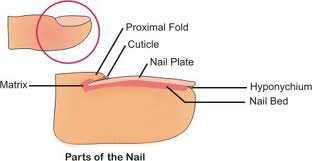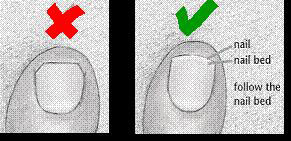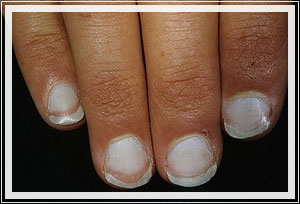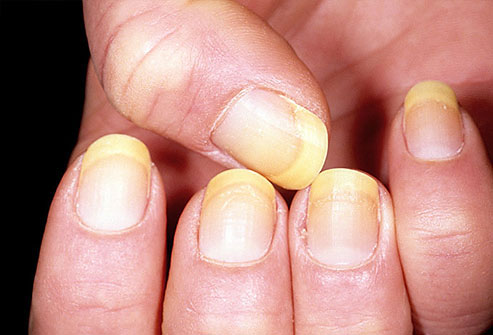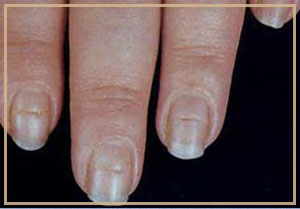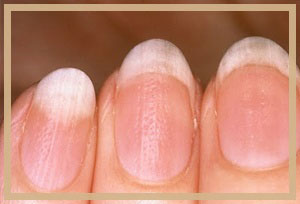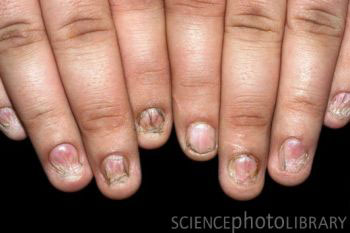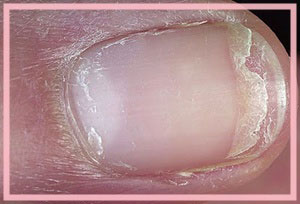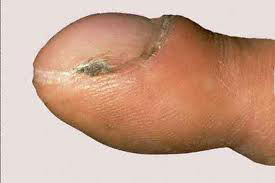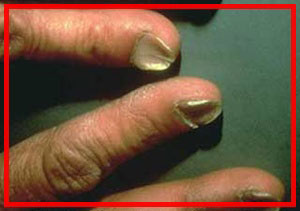Nails have their own functions, have tell-tale signs of certain diseases and nail itself can be exposed to certain diseases.
What is a nail?
The nail plate is the actual part of the nail we see. It is made up of laminated layer of translucent keratin. This nail plate grow from the base of the nail. As new cells grow, the older cells got pushed outwards to the finger tips in the form of hard compact layer of keratin. Fingernails grow at a rate of about 3mm per month and this is two to four times the rate of the toe nails.
The nail bed is the layer of skin where the nail plate rests on. The colours of the nails are actually the colour of the nail bed which are rich in capillaries and glands. Thus the colour of your nails may tell a lot about your health.
The cuticle is at the proximal end of the nail. It is actually a shed of dead almost invisible skin layer which folds back upon itself protecting the newly formed nail plate.
What is the function of your nail?
- Protection
- It protects the last piece of bone in the finger or toes. It protects the finger tips and the surrounding soft tissue.
- Facilitate functions of fingers
- The function of finger tips is for touch and picking up small things. The nail facilitate fine movements by providing counter pressure on the pulp of the finger thus increasing its sensitivity.
- Cosmetic/fashion
- Adolescents love to apply nail polish, ‘inai’ or nails accessory to make them look more beautiful.
- As a tool
- Can be use for scratching.
- It also serves an important function in extended precision grip like when you use your nails and tip of finger to pull-out a splinter.
How do you take care of your nails?
For you to keep your nails healthy, you must know how a healthy nail looks like.
- Healthy nails:
- Are clean
- Have smooth surface without ridges or grooves.
- Have uniform colour. It should be free from spots or discoloration.
- However as someone aged,vertical ridges may develop.
Taking care of your nails.
- Keep your nails short
- Cut your toe nails straight across. Do not dig down on the sides. This is to avoid in-grown toe nail and infection.
- Long nails tend to split and break easily and may cause injury to yourself.
- Not too short as it may hurt and is exposed to infection.
- Keep your nails and fingers moist.
- Use moisturiser several times a day
- Apply nail polish
- Nail polish can keep the moisture in the nails. However it may not be practical for some people especially muslims as they need to perform ablution (wudhu’) at least 5 times a day.
- Avoid using nail polish remover too often.
- Try limit the use to maximum of once a week
- Do not remove your cuticles.
- Removing it can expose your nails to infection
Nails are also exposed to nail diseases. It is important to recognise some common condition to assist you in seeking help for treatment.
- Bacteria infection
- Infection of the nail fold. Usually caused by bacterial infection although fungi is a known cause of infection.
- Fungal infection
- This is a common condition. The nails may get infected by yeast, fungus or ringworm. The nails may appear thickened, deformed as there may be separation of the nail plate from the nail bed. However treatment is available.
- In-grown nail
- It is a condition when the nail grow into the nail bed and cause severe pain and may get infected. This is usually associated with wrong way of cutting the finger nails and with obesity. It occurs more commonly in the big toe.
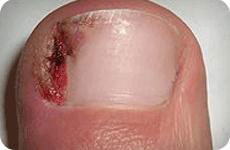
Nail Biting
Some people love to bite their finger nails. This is not a good habit. Nail biting is considered a disease called impulse control disorder. The person having it have problem controlling the habit to bite their finger nails. It is also often associated with other behavioural or emotional disorders. It usually occur during childhood and adolescence.
Nail biting many result in broken skin on the cuticle. This may introduce infection. There may also be dental problems, or gum injury. When the bitten off nails are swallowed, it may transfer infection buried under the surface of the nails to the stomach. Pinworms and bacteria from the anus region can be transferred to the stomach causing stomach problems.
Bitter tasting nail polish may discourage nail bitting. Some behavioural therapy technique may be used in the treatment to stop this habit.
Is it safe to use nail polish?
The issues in using nail polish are:
- The possible dangerous chemicals which may be found in it.
- It may contain a chemical called dibutyl phthalate (DBP). DBP is a plasticizer that may disturb the endocrine function and cause birth defects. Toulene and formaldehyde are possible carcinogens which may also be present in the nail polish. Safe nail polish should be odorless , should not contain the above chemicals or ethylacetate, N Butyl acetate and acetone.
- The effects of the nail polish remover.
- It usually contains acetone which will leave the skin dry. Acetone is also inflammable. Some people are sensitive to it.
You must be very careful in choosing your nail polish and nail polish remover. You may be getting yourself exposed to dangerous chemicals and risk of developing allergic reactions to it. Better still, think first whether you really need to use the nail polish.
What can nails tell you?
|
Appearance
|
Possible conditions
|
|---|---|
|
White nail
|
|
|
Yellow discoloration
|
|
|
Indentations across the nail
|
|
|
Pitted nail
|
|
|
Curled nails
|
|
|
Nail clubbing
|
|
|
Spoon nails
|
|
In summary, please keep your nails clean and any uncertainties you have about how your nails look like, consult your doctor.
| Last Reviewed | : | 28 August 2020 |
| Writer | : | Dr. Salmah bt. Nordin |
| Accreditor | : | Dr. Nik Rubiah bte. Nik Abdul Rashid |
| Reviewer | : | Dr. Nazhatussima bt. Suhaili |


